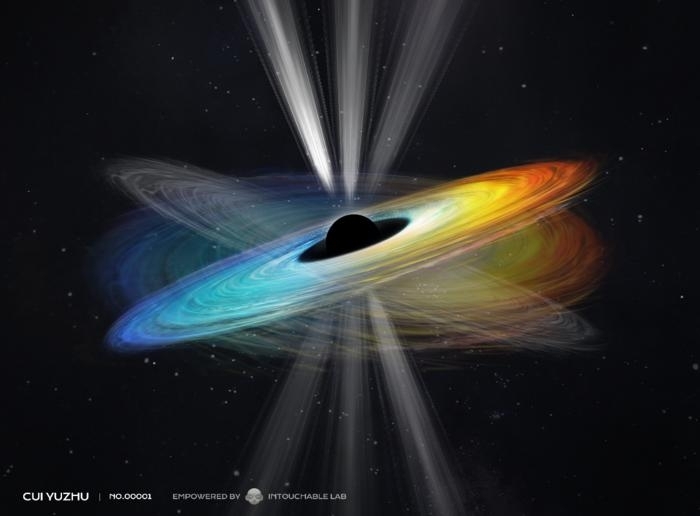China confirms black hole spin by monitoring radio galaxy M87

An international team of researchers, led by Chinese researcher Dr. CUI Yuzhu, has discovered that the black hole at the center of the nearby radio galaxy M87, which is located 55 million light-years from Earth and is 6.5 billion times more massive than the Sun, exhibits an oscillating jet that swings up and down with an amplitude of about 10 degrees. This confirms the black hole's spin.
The team used a global network of radio telescopes and analyzed telescope data from 2000 to 2022. Through this extensive analysis, they revealed a recurring 11-year cycle in the precessional motion of the jet base, as predicted by Einstein's General Theory of Relativity. This study offers evidence that M87's black hole spins and links the dynamics of the jet with the central supermassive black hole.
Supermassive black holes at the center of active galaxies are known to be the most disruptive celestial objects in our universe. Due to their extraordinary gravitational force and power of plasma outflows, they can accrete tremendous amounts of material. These outflows, known as jets, approach the speed of light and extend thousands of light-years away.
For over a century, physicists and astronomers have been trying to understand how energy is transferred between supermassive black holes, their accretion disks, and relativistic jets. The most widely accepted theory suggests that a spinning black hole can extract energy, which can then be used to eject some of the material surrounding the black hole with tremendous force. However, despite being a crucial factor in this process, the spin of supermassive black holes, which is the most fundamental parameter other than black hole mass, has never been directly observed.
In this study, the research team focused on M87, which is known for having the first observational astrophysical jet that was ever observed in 1918. The jet formation regions that are close to the black hole can be analyzed in detail with Very Long Baseline Interferometry (VLBI) because of their proximity. Recent black hole shadow imaging with the Event Horizon Telescope (EHT) has further allowed researchers to study M87 in detail. By analyzing VLBI data from M87 that was collected over the last 23 years, the team was able to detect the periodic precessional jet at the base of the black hole, which provided insight into the status of the central black hole.
At the heart of this discovery lies a critical question: What force in the universe can alter the direction of such a powerful jet? The answer could be hidden in the behavior of the accretion disk, a structure related to the central supermassive black hole. As materials fall towards the black hole, they form a disk-like structure due to their angular momentum before spiraling inwards and being inevitably drawn into the black hole. However, if the black hole is spinning, it exerts a significant impact on surrounding spacetime, causing nearby objects to be dragged along its axis of rotation, a phenomenon known as "frame-dragging" that was predicted by Einstein's General Theory of Relativity.
The research team's analysis indicates that the rotational axis of the accretion disk does not align with the black hole's spin axis, leading to a precessional jet. Detecting this precession provides unequivocal evidence that the supermassive black hole in M87 is indeed spinning, thus enhancing our understanding of the nature of supermassive black holes.
"We are thrilled by this significant finding," said CUI Yuzhu, a postdoctoral researcher at Zhejiang Lab, a research institution in Hangzhou, and lead and corresponding author of the paper. "Since the misalignment between the black hole and the disk is relatively small and the precession period is around 11 years, accumulating high-resolution data tracing M87's structure over two decades and thorough analysis are essential to obtain this achievement."
"After the success of black hole imaging in this galaxy with the EHT, whether this black hole is spinning or not has been a central concern among scientists," added Dr. Kazuhiro Hada from the National Astronomical Observatory of Japan. "Now anticipation has turned into certainty. This monster black hole is indeed spinning."
The work involved a total of 170 observation epochs, conducted by various radio telescopes across the world, including the East Asian VLBI Network (EAVN), the Very Long Baseline Array (VLBA), the joint array of KVN and VERA (KaVA), and the East Asia to Italy Nearly Global (EATING) network. Among these, China's Tianma 65-meter radio telescope and Xinjiang 26-meter radio telescope played a crucial role in achieving the high sensitivity and angular resolution required for the project. The data obtained from over 20 telescopes provided valuable insights for the study.
"The in-building Shigatse 40-meter radio telescope by Shanghai Astronomical Observatory will further improve the imaging capability of EAVN at millimeters. Especially, the Tibetan Plateau, where the telescope is located, owns one of the most excellent site conditions for (sub-)millimeter wavelength observations. It fulfills our expectations to promote domestic sub-millimeter facilities for astronomical observations," said Prof. SHEN Zhiqiang, Director of the Shanghai Astronomical Observatory of the Chinese Academy of Sciences.
This study provides insights into the enigmatic realm of supermassive black holes, but it comes with its own set of challenges. The exact spin of the M87 supermassive black hole and the structure of its accretion disk remain uncertain. Furthermore, this research predicts that there could be more sources with similar characteristics, which presents a challenge for scientists to discover them.
Recently, China confirmed the existence of a supermassive black hole at the center of radio galaxy M87 and provided evidence of its rapid spin. This discovery has implications for our understanding of how galaxies are formed and evolved. It also highlights the importance of international collaboration in advancing scientific knowledge. As we further explore the mysteries of the universe, this discovery reminds us of the power of human ingenuity and the potential of science to unlock the secrets of the cosmos.

 How to resolve AdBlock issue?
How to resolve AdBlock issue?